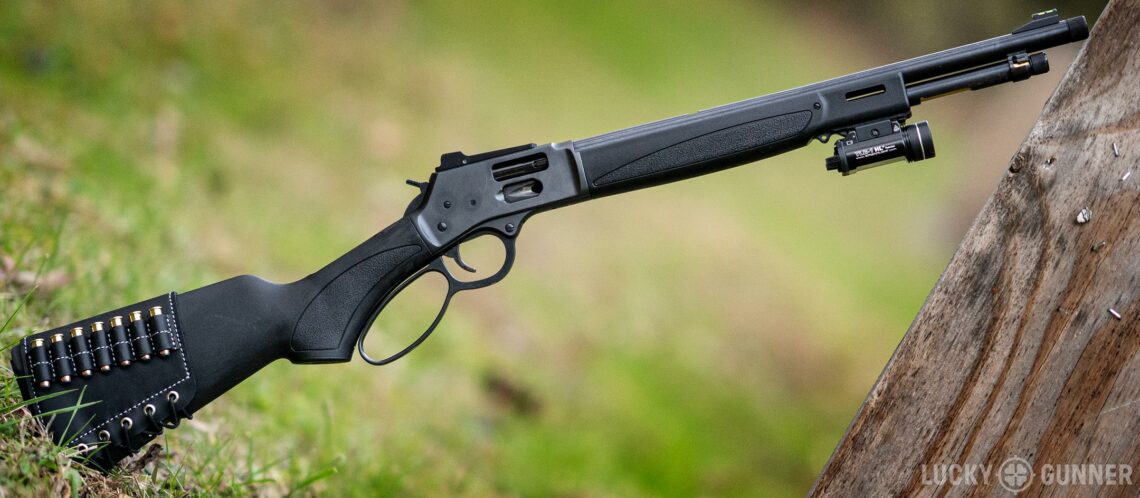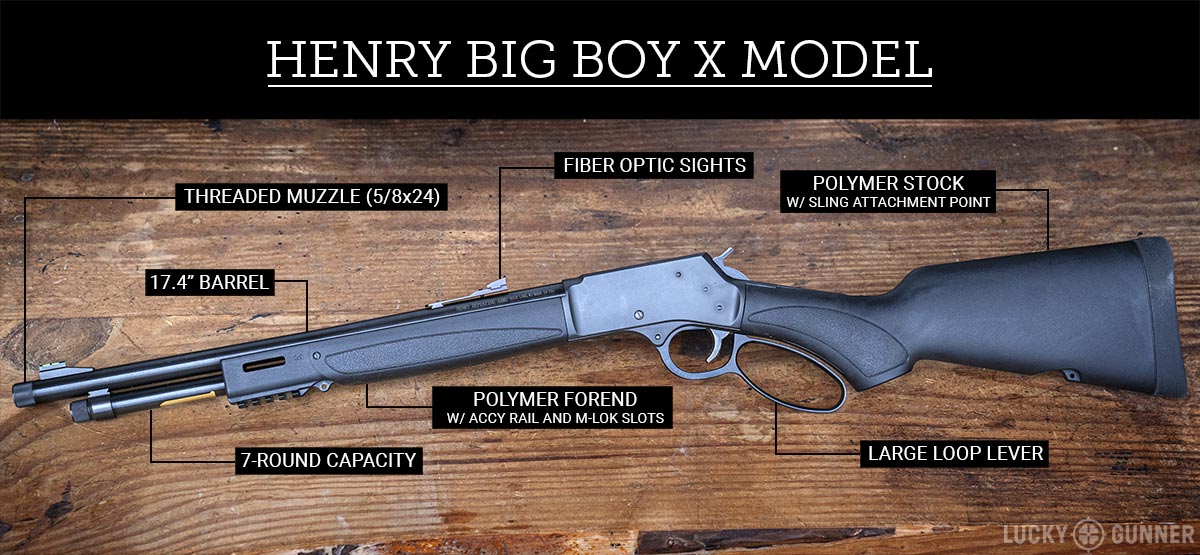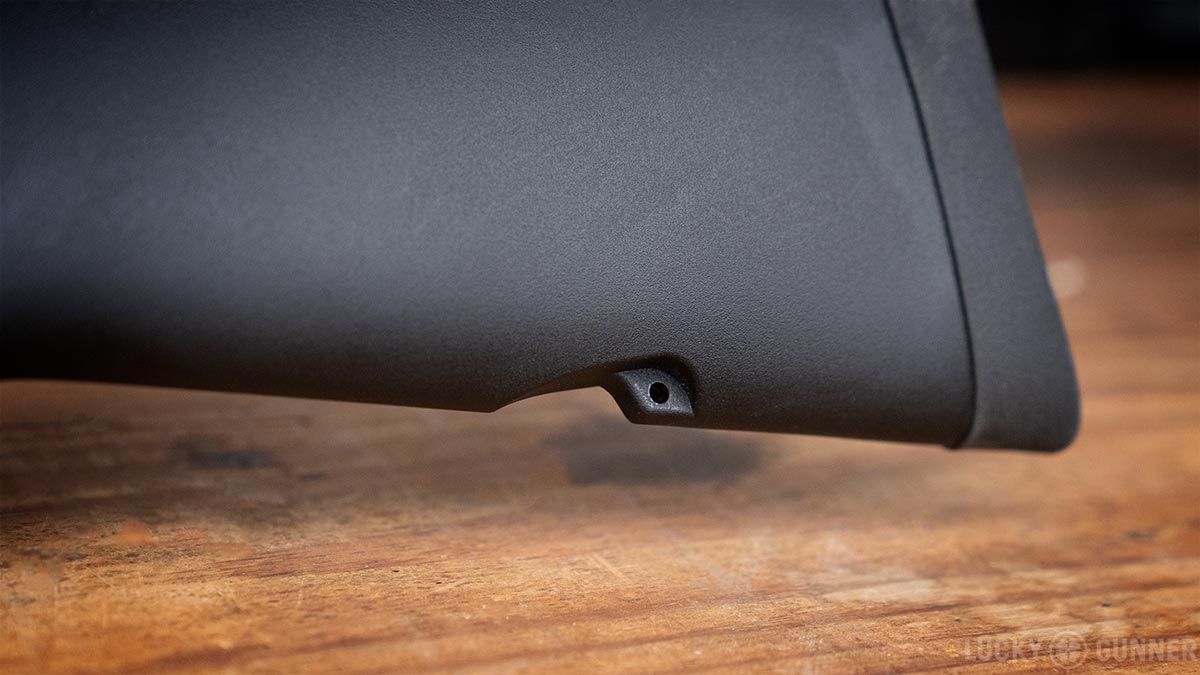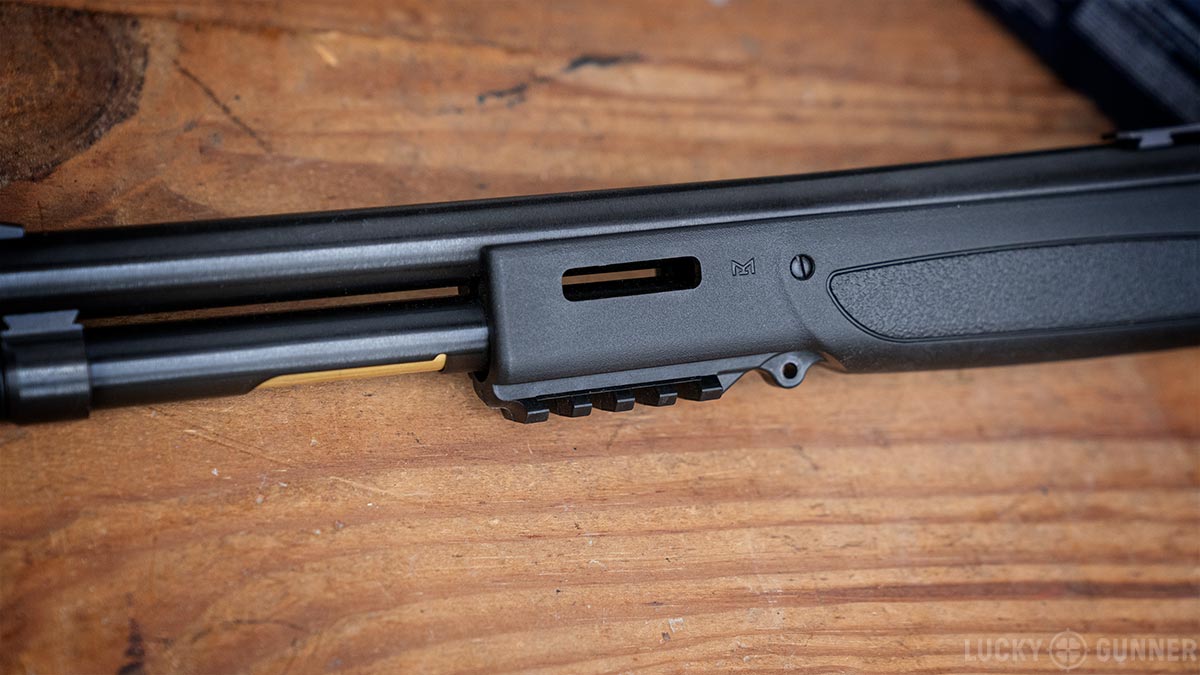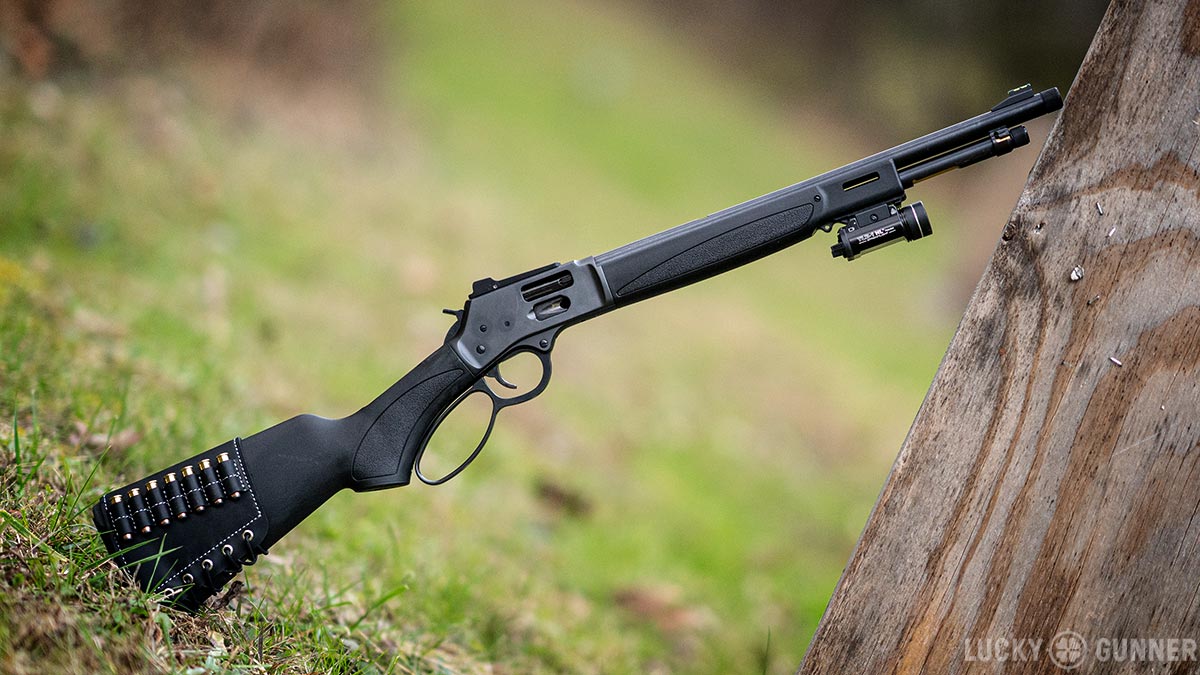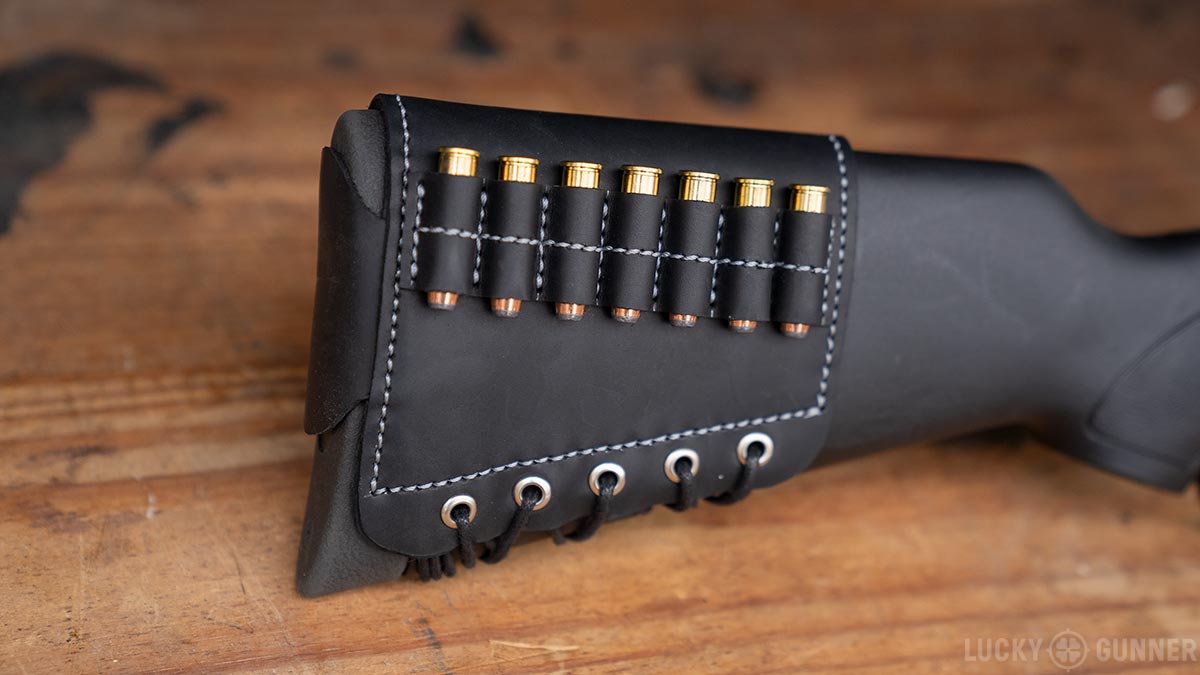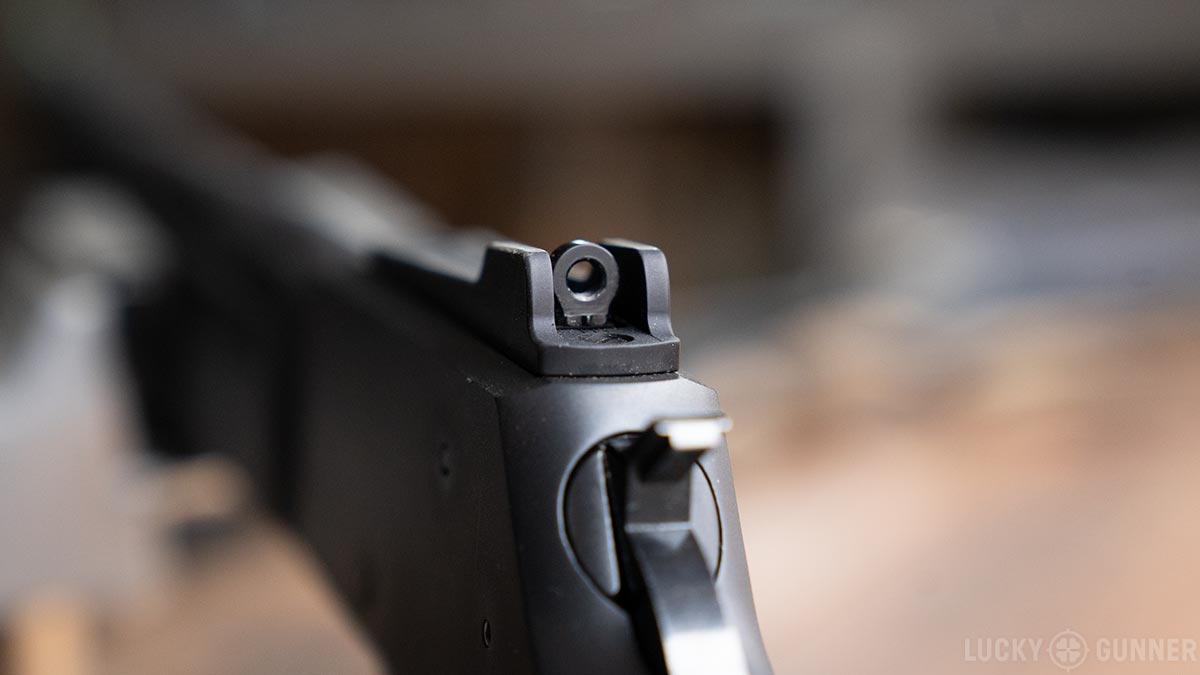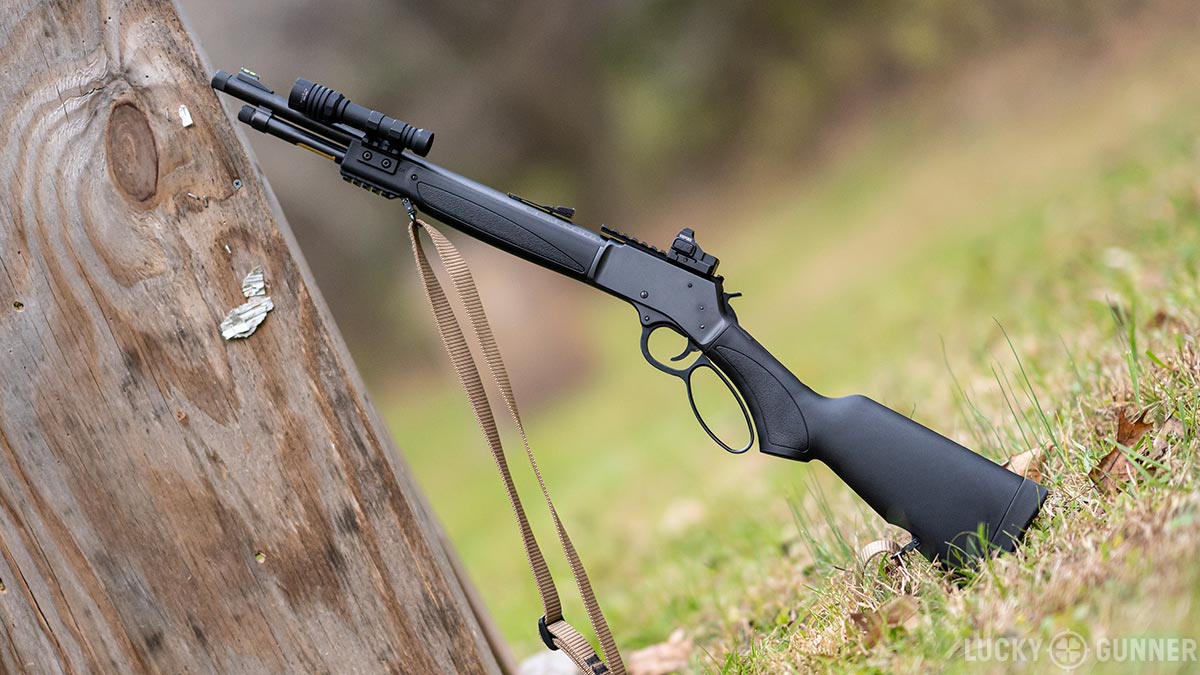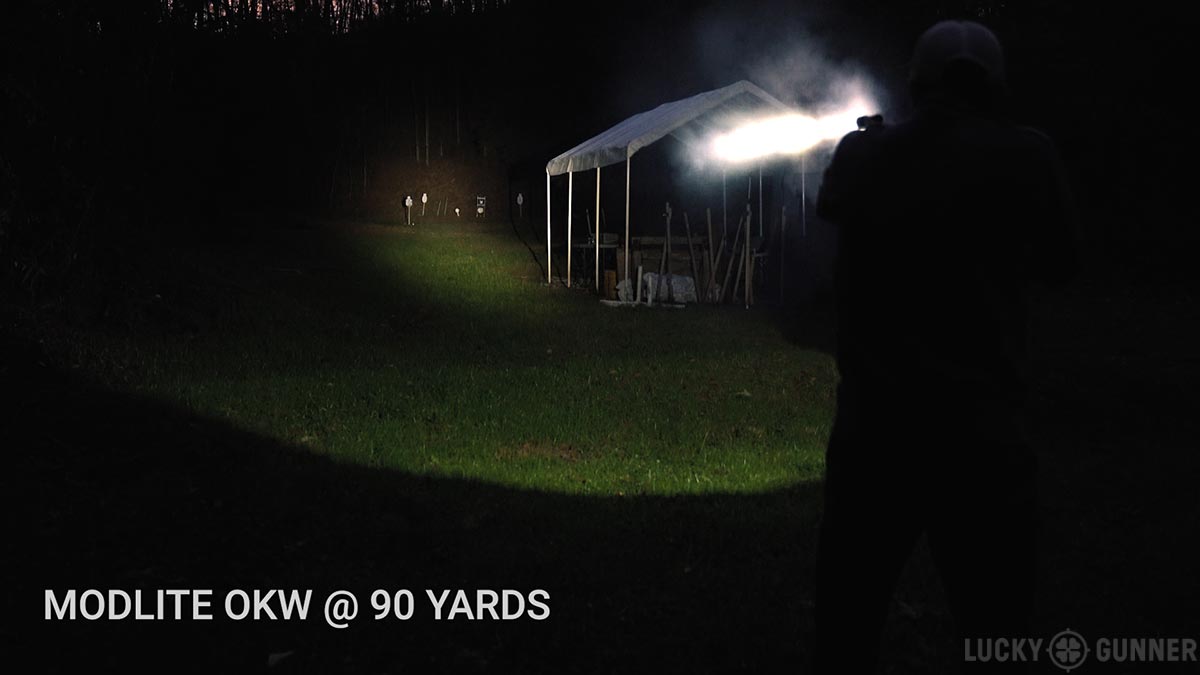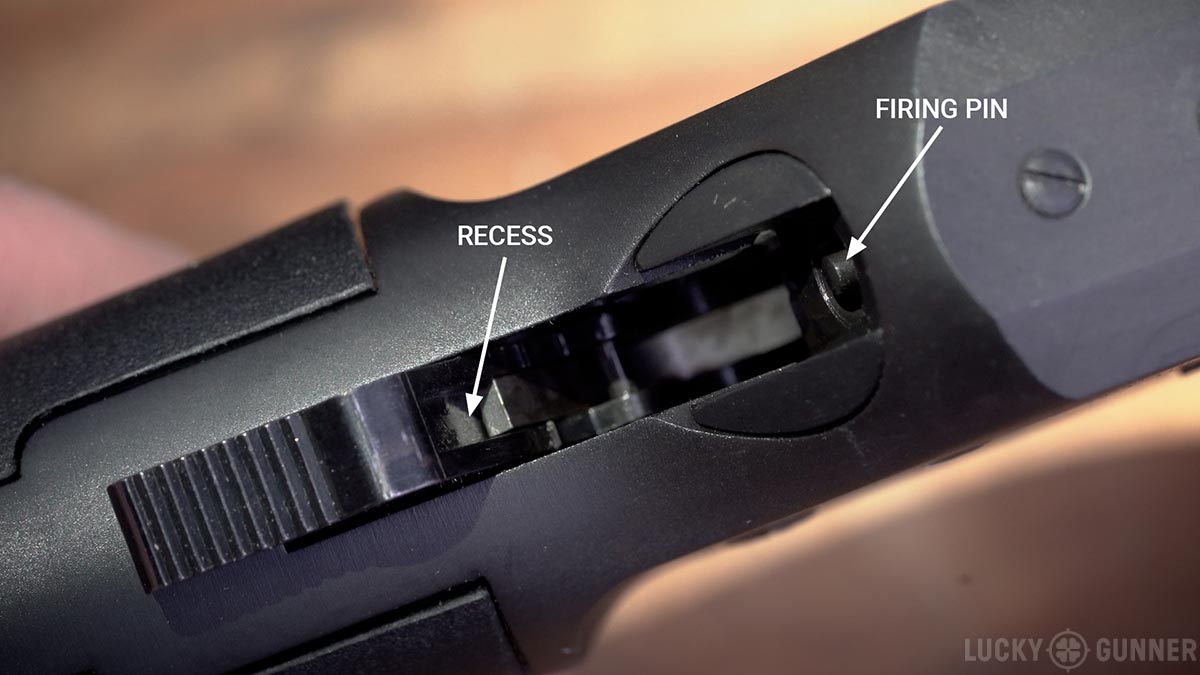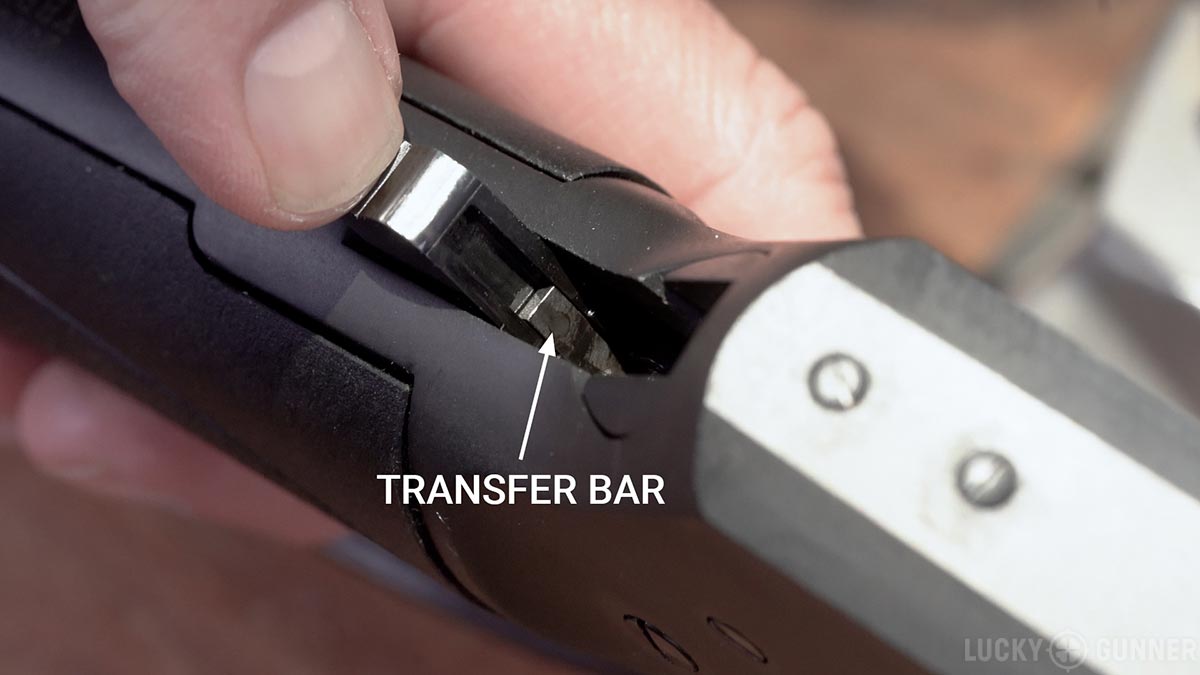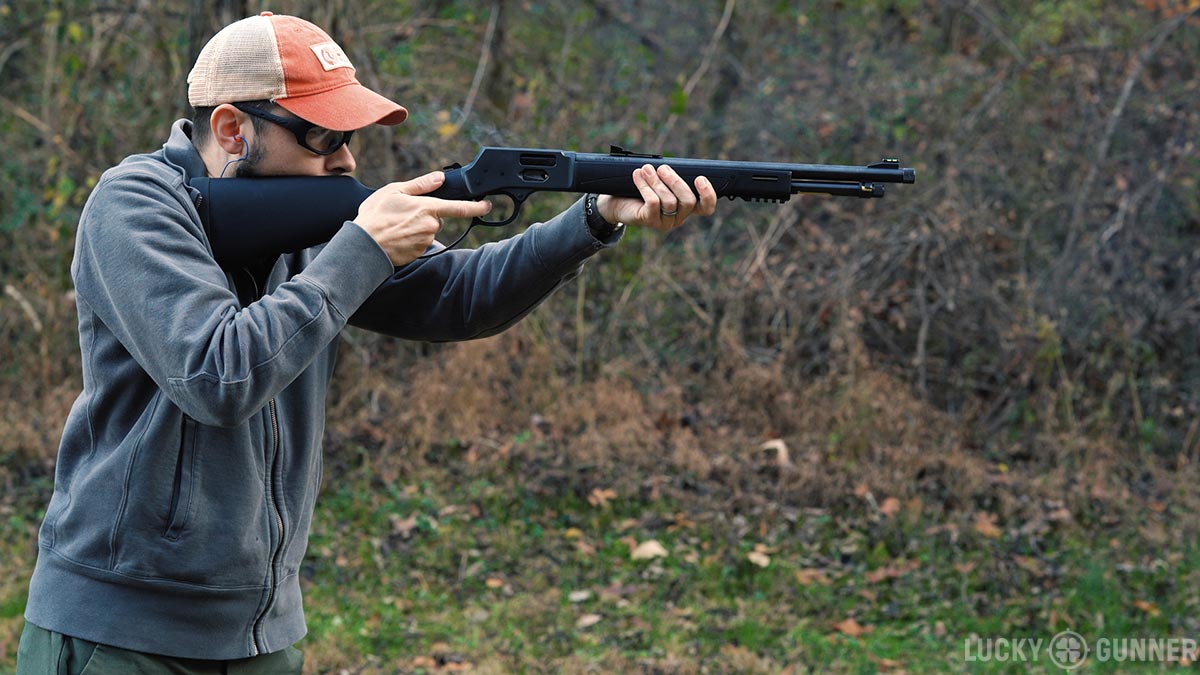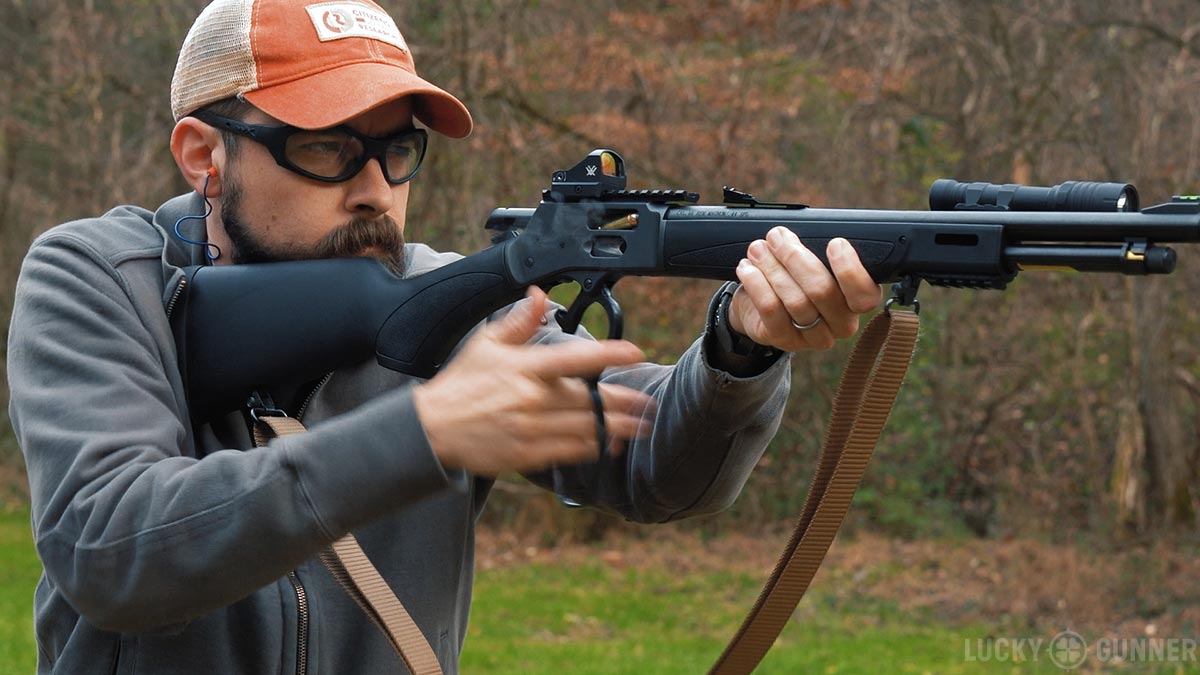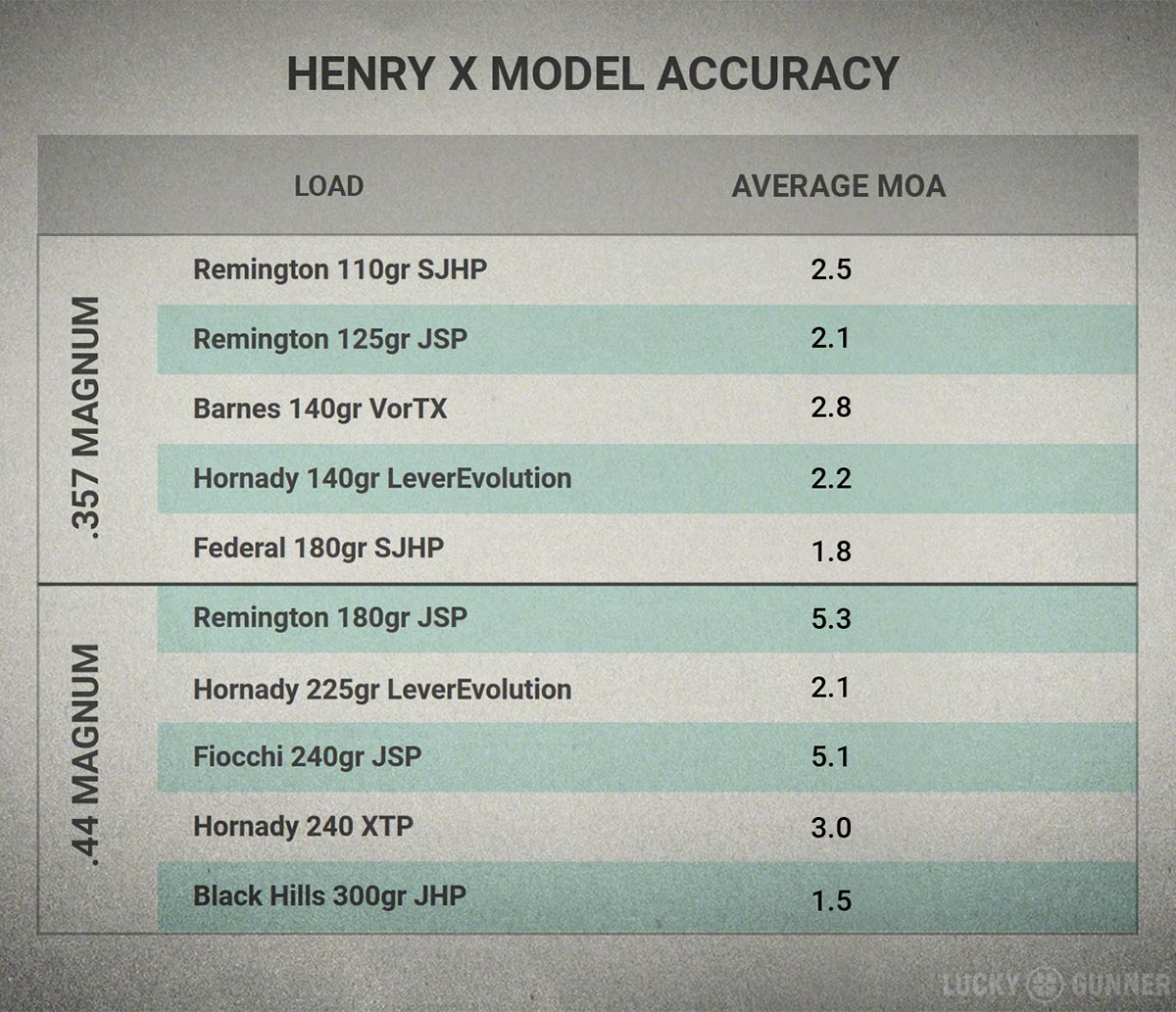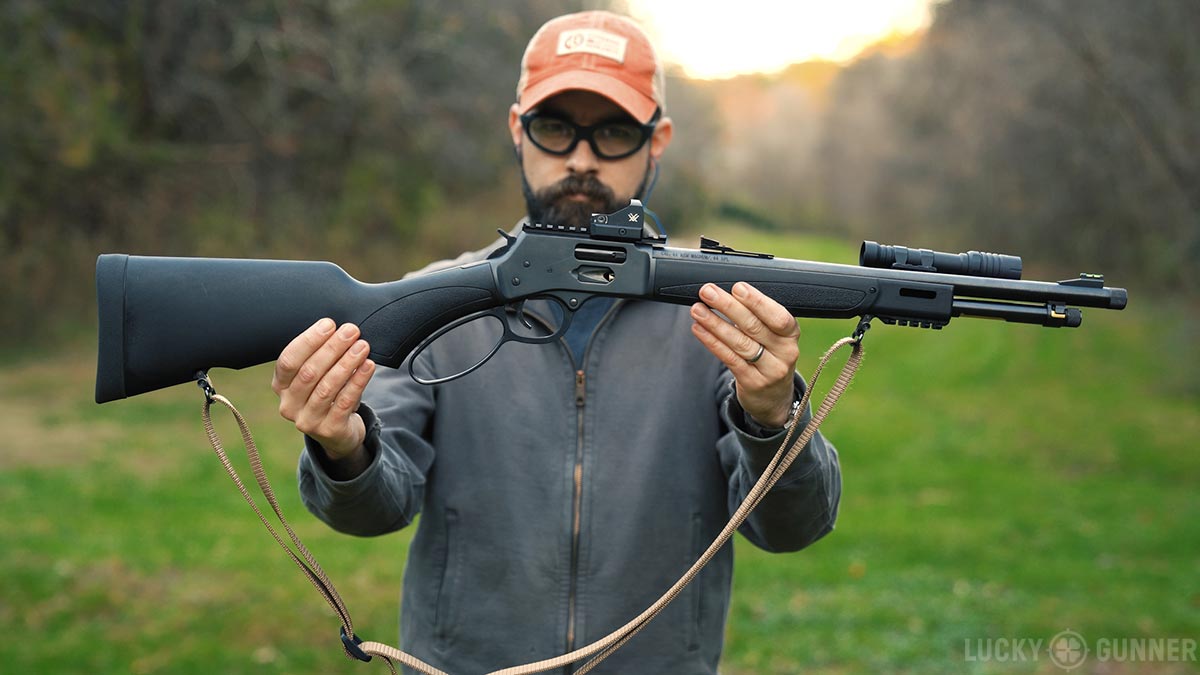Today, we’re reviewing the Henry Big Boy X Models; both the .357 Magnum and .44 Magnum versions. The X Model is Henry’s take on a classic lever action with some more modern features. We’re looking at what we think Henry did right, what could use some improvement, and how the X Model compares to some of the other “modernized” lever actions on the market.This is the fourth installment of our Lever Action Series. Be sure to check out the rest here.
Watch the video below for all the details, or keep on scrolling to read the full transcript.
Hey guys, Chris Baker here from LuckyGunner.com. If you’ve followed our lever action series so far, then you’ve seen these rifles before. Henry Repeating Arms very kindly loaned us a pair of their Big Boy X Models to use for this video series. These two guns are identical except that one is chambered in .357 Magnum, and the other is a .44 Magnum. They were our test rifles for the .357 versus .44 video. Today, I’m taking a more detailed look at the rifles themselves.
Henry Big Boy X Models: Features and Specs
Let’s start with a quick overview of the basics. We’ve got a 17.4-inch barrel. A tubular magazine with a 7-round capacity (and I was able to fit 8 rounds in there with .38 and .44 Specials). Polymer furniture with accessory attachment points on the forend. Fiber optic sights. An enlarged lever loop. The muzzle on both rifles is threaded with a 5/8×24 pitch so you can run them with a suppressor.
Like all of Henry’s tube-fed rifles, these can be loaded from the top of the tube, but the X Models also have a side loading gate in the receiver. The listed weight for these rifles is 7.3 pounds. That was spot on when I weighed the .357 version, but the .44 actually came in closer to 7 pounds even. Of course, that makes sense because the larger bore size means less material in the barrel. Henry also has a .45 Colt version of the Big Boy X Model and I would expect that one to weigh roughly the same as the .44 version.
Some of the naming here might be a little confusing If you’re not already familiar with Henry’s product lineup. The Big Boy series is their line of pistol caliber lever actions. They’ve been making those for a long time. The Big Boy X Models are the new rifles with the more modern features like the polymer furniture and the threaded muzzle. They’ve got a couple of other guns outside of the Big Boy series that have also gotten the X Model treatment. One is a .410 lever action shotgun and the other is their .45-70. There is not a .30-30 X Model yet but I wouldn’t be surprised if they rolled out something like that in the future.
The Side Loading Gate: Kind of a Big Deal
Since the company launched in 1996 one of the things Henry’s rifles have been known for is the top-loading magazine tube. This is not something you can usually find on rifles being made today with the exception of a few .22s.
To load the mag tube, you have to first remove this rod that contains the mag spring and the follower. Then you can drop the rounds down into the tube, then replace the rod. If you want to unload the rifle, just remove the rod and tilt the muzzle down to dump out all the rounds.
This is a much more convenient and safer method of unloading the gun than cycling all the rounds through the action like you have to do with most lever guns. But the loading process is not always ideal. It’s slow and tedious, especially if you just want to load a couple of rounds or top off the mag tube after firing a couple of rounds. Until very recently, that’s how you had to load a Henry because none of them had side loading gates.
Obviously, this is not really a big deal for a lot of shooters or Henry would not have become as successful as they have. But for others, myself included, not having a side loading gate in the receiver is kind of a deal breaker. I wanted to like Henry lever actions for a long time, but no loading gate made that difficult and I know I’m not alone in that.
Then last year, for the first time Henry introduced new versions of a couple of their more popular models that included a side loading gate. Following that, the X Models were announced at the beginning of this year and they are the first Henrys to bring the side gate to their pistol caliber lever actions. And it would seem as though that’s been a welcome change because just in the last week, Henry announced that they’re adding the side gate to all of their steel centerfire models. So it looks like side loading gates might be the new normal for Henry going forward.

Henry X Model vs The Other Guys
At first glance, the X Models kind of resemble some of the other black lever actions that have hit the market lately like the Marlin Dark Series and the Rossi Triple Black. Those might be nice guns, but there are a few things I think Henry did better.
Large Lever Loops: Feature or Bug?
Let’s start with the lever loop. It’s larger than a standard loop, but smaller than a lot of the oversized loops that are en vogue these days. I like the standard size loops, but they can feel a little cramped if you try to shoot with gloves or if you have large hands. You can usually get around that by shooting with your little finger outside the loop. But everybody thinks they would rather just have an extra large lever loop instead.
Until they actually try to use one.
The opening on a standard Henry lever is about an inch wide. The big loop for this Marlin Dark Series is about two inches in the middle.
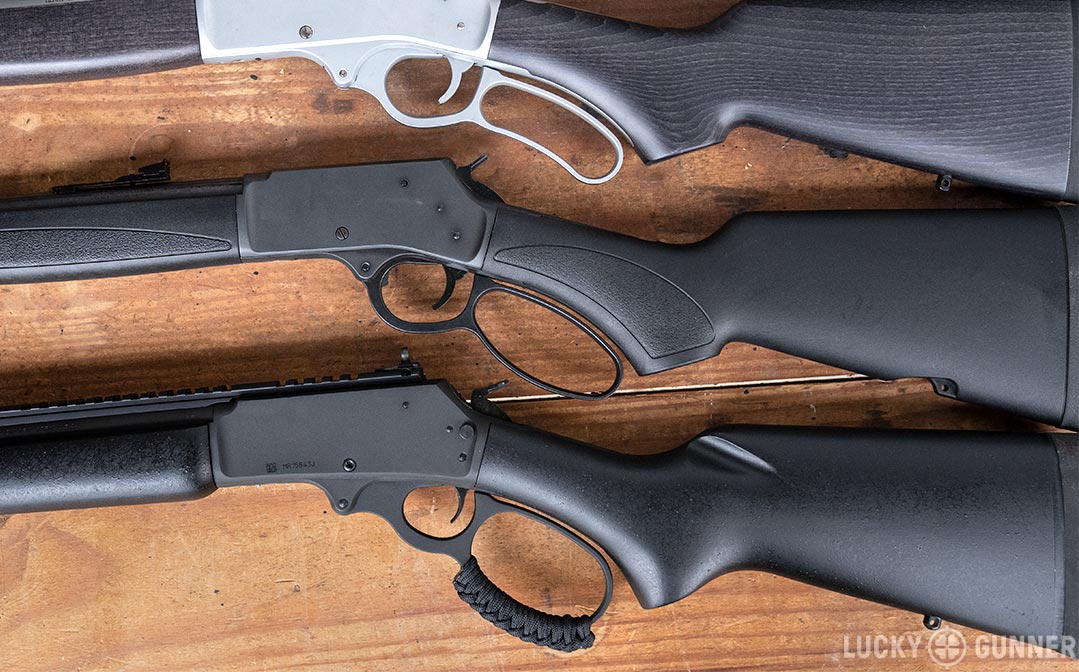
The really big loops can slow you down if you like to run the action fast. If the action gets a little hung up for some reason, your hand is more likely to fly right out of a big loop. But the main issue is really comfort. With a big loop, instead of pushing the lever open, you smack it open with the back of your fingers. Since the back of your fingers are basically just skin and bones, that’s not particularly comfortable when you’re running the action vigorously.
On this Marlin and the Rossi Triple Black, they have addressed this problem by adding a paracord wrap to the lever to act as a kind of cushion for your hand. That’s not a bad solution, but I would argue that it introduces a potential failure point. If the wrap were to loosen over time, it could work its way back and prevent the lever from closing all the way, which essentially disables the gun until you fix it. The wrap on this Marlin seems nice and tight, it’s probably not going anywhere for a while. But that is something I have had happen with an aftermarket lever wrap in the past.
Henry has kind of taken a middle road. They simply use an enlarged loop that’s not quite so big. The opening is an inch and a half wide in the middle. It’s got a lot more room than the standard lever loop, but it’s not massive. It definitely cuts down on the abuse your fingers get over a long range session. The Henry action is pretty smooth right out of the box anyway, so there’s not as much resistance when you’re trying to run the lever to begin with.
Wood is Not Always Good
The other thing I think Henry got right is the stock. The X Model’s forend and stock are polymer. Marlin and Rossi both went with wood furniture that’s painted black.
I love a nice wood stock and the Henry would look fantastic with something like checkered dark walnut. But for a rifle that’s actually going to get some practical use, plastic makes a lot of sense. There’s no wood finish that’s as weather-proof as polymer. You don’t have to baby a polymer stock or worry that it’s going to get scratches or dings when you drag it through the woods.
The other advantage of polymer is that it can be molded into shapes that would be impractical for wood. So in the buttstock, they molded this little recessed area with a snag-free attachment point for a sling swivel.
The forend has the real distinctive feature of this rifle: on the bottom, a standard picatinny rail and a second sling mount. And on the sides, these holes are actually M-LOK accessory slots. So you’ve got three places you can attach accessories directly to the forend and it doesn’t look like a prop from a low budget sci-fi movie.
Accessories and Configurations
I’ve set these rifles up a couple of different ways just to try them out with some accessories. Here’s what I’ve done with the .357 Magnum X Model.
The forend rail is ideal for attaching a light. If you’re using this gun for personal protection, either in the home or outdoors, positive target identification is an absolute must. I’ve stuck a Streamlight TLR-1 on here. This is intended to be used on a handgun, but it works great for this application, too. It’s really easy to take on and off without any tools. I might worry about this kind of light coming loose on a larger caliber rifle. But the recoil of the .357 and .44 are pretty light relative to the weight of these rifles and it hasn’t moved a bit after shooting a full box of magnums.
On the buttstock here I’ve got an ammo carrier. This is probably the easiest way to keep ammo on the gun so you can top off the mag tube without digging into your pockets. The best part about these things is that they don’t have to be made specifically for the gun you put them on. You just have to make sure the ammo loops are the correct size for the cartridges you’re carrying. Aside from that, pretty much any generic leather ammo carrier will probably fit the gun. There are some mass produced ones, but there are also tons of small time leather workers that make them. I got this one from a seller on Etsy called WildWildDill. It’s not made from the most premium grade leather, but it’s plenty functional and it doesn’t slide around.
On this X Model, I also changed out the iron sights. I removed the original fiber optic open sights and installed this Ranger Point Precision aperture sight. The receiver is drilled and tapped from the factory, so this takes about 90 seconds to install. If I was planning to leave this on here permanently, I’d get some kind of filler to protect the dovetail.
The Ranger Point rear sight is fully adjustable for windage and elevation. I got lucky and it was almost perfectly zeroed right after I installed it, so I had to adjust it very little. So, fortunately, the Ranger Point rear sight is compatible with the X Model front sight. There are other rear apertures available for the Henrys like the well-regarded Skinner sights. They might also work fine with the factory front sight, but I can’t confirm that.
I got the version of the Ranger Point Precision sight that comes with a traditional small aperture insert. That’s easily removable and then you’re left with a big ghost ring. I personally prefer a ghost ring over a small aperture on a rifle that’s going to be used at short range like this one. I also think a ghost ring is easier to use in low light than a typical bladed rear sight. However, the factory fiber optic rear sight blade on the X Models is not bad at all. It’s a lot easier to use in dim lighting than the traditional buckhorn sights you find on most lever actions.
I went a slightly different route with the .44 Magnum X Model.
I threw my Wilderness Tactical Rhodesian Sling on here. Instead of switching out the iron sights, I’ve got a Vortex Viper red dot sight mounted on a picatinny rail. A few companies make picatinny rails for the Henrys. I got this one from Ranger Point Precision, but only because I was already ordering a bunch of stuff from them.
You could just as easily drop a magnified optic on here. But as far as I’m concerned, a simple, red dot optic is perfect for a gun that’s very rarely going to be used beyond 100 yards. It keeps the weight down and handles better than having a big scope on here.
On the forend, I’m using one of the MLOK slots with a Magpul offset mount to attach a Modlite OKW. These lights are completely insane. A little on the pricey side, but worth it if you need a light that can really reach out. It has a super concentrated beam that will light up a target out to at least 300 yards. It was actually designed to be used with designated marksman rifles with low power optics.
Obviously, you’re not going to be taking 300 yard shots in the dark with a pistol caliber lever action. The Modlite OKW is complete overkill for this gun. But if you’re using your X Model for something like pest control on your property or a farm, you probably do want a light that has a lot of throw as opposed to a wider beam.
The Henry Transfer Bar Safety
If you’re accustomed to shooting Marlins, you might notice the lack of an external manual safety on the Henry. It also doesn’t have a half-cock position for the hammer. However, it does have safety features.
When you cock the hammer, you can see the rear of the firing pin in the back of the receiver there. And then if you look at the striking face of the hammer, you’ll notice a corresponding recess cut out in the middle of it.
When you press the trigger, a transfer bar slides up into that recess and that bar is actually what strikes the firing pin.
But if I press the trigger just briefly to release the hammer and then take my finger off the trigger, the transfer bar stays down. So now if the hammer falls, the gun won’t discharge. And when the hammer is lowered, the gun can’t discharge from an impact on the hammer. This essentially does away with the need for a half-cock notch. After you chamber a round, you can carefully decock the gun and carry it in the field that way. When you’re ready to shoot, just cock the hammer and go.
The Henry X Model at the Range
With ammo in short supply, I haven’t had as much range time with these guns as I normally like to have for a review. I’ve run about 300 rounds through each gun, so I do have some initial impressions. Like I mentioned earlier, the action is very smooth. You can get a Marlin or a Winchester tuned by a gunsmith and it’ll be even better, but for something right out of the box, the Henry action is really nice.
The .357 X Model has run like a top. It’s cycled every round I’ve run through it without the slightest hiccup. Most of that has been soft point Magnum ammo, but I did fire a box of .38 Special FMJs and those cycled fine, too. Some lever actions have a hard time with the shorter cartridge length of the .38s, but this one did okay, at least with the full metal jackets.
There is one little quirk I ran into. The Hornady LeverEvolution rounds with the polymer tip FTX bullets are difficult to load through the side gate. And I can’t really tell exactly what’s going on there. Somehow, the rounds are getting hung up if you don’t load them at just the right angle. Once they’re in there, they cycle just fine. But if you wanted to keep some rounds handy for a quick reload, just be aware the FTX bullets might slow you down.
The .44 Magnum X Model gave me some problems early on. It would not release a shell from the mag tube onto the carrier. So you’d try to cycle the action and the lever would just stop before it went all the way out. Every now and then I could kind of coax it into working, but clearly, something was not right. So I sent that one back to Henry and they returned it with a new carrier. Apparently the first one was out of spec. I haven’t run into that problem again, so I guess that fixed it.
Besides that, I have had a couple of minor ammo-related issues with the .44. The first one is with Fiocchi flat nose .44 Magnum rounds. You can see it happen a couple of times in this clip:
Sometimes, the round will be angled a little high on the carrier as it approaches the chamber. That flat nose hits the top of the chamber and just gets stuck there. It’s pinned between the bolt and the chamber mouth. If you let the action back out, the round will fall back onto the carrier and it usually goes in on the second try.
The other ammo issue was with Remington lead round nose .44 Specials. These bullets are pretty soft and it seems like that was causing them occasionally to get hung up a little when they came out of the mag tube.
It’s hard for me to fault the rifle for these issues, though. We’re talking about lever actions firing cartridges that were designed to be fired out of revolvers. Revolvers don’t have to feed. They don’t care what shape the bullet is or how long it is. For lever actions, ammo sensitivity just comes with the territory. Except for the original carrier on the .44, these rifles have run as well as I expect a pistol caliber lever action to run.
Accuracy
Accuracy is probably not your first priority when you’re shopping for a pistol caliber lever action. But it’s worth talking about just briefly. I had the chance to shoot plenty of bench rest groups with these guns when I was doing ammo testing for the .357 versus .44 Magnum video. The five .357 Magnum loads were pretty consistent with an average 5-shot group size around 1.8 to 2.8 MOA. That translates to groups roughly in the neighborhood of 1 to 2 inches at 50 yards.
Three of the five .44 Magnum loads had similar performance with groups averaging 1.5 to 3 MOA. The other two loads were a little over 5 MOA. So, a bit more variation with the .44s.
Overall, that’s not bad for these cartridges. Especially when you consider that at least half of the loads I tested are not exactly premium top-shelf target loads. You might have to experiment a little, but you shouldn’t have to go through a whole lot of trial and error with these guns to find a load that will get you decent groups at 50 to 100 yards.
A Suggested Change
There is one change that I think would make the Henry X Models a lot better: the length of pull. I’ve measured it at 14.25 inches. That is just way too long. I like my lever action stocks short, just like my shotgun stocks. I’m 5’9” and I want the length of pull at about 12.5 inches. That allows me to really bring the gun off my shoulder and closer to the centerline. That way, you get less movement in the rifle when you cycle the action. I think it also helps you run the lever more aggressively.
But even if you shoot with a more traditional bladed stance, that length of pull is going to be super annoying for anyone less than about five and a half feet tall. That’s a shame because a low recoil gun like this would otherwise be perfect for a smaller statured person. The long stock negates that benefit. You might be able to cut the stock down or see if a gunsmith will do it. I think a much more user-friendly option would be for Henry to ship the gun with a shorter stock and include spacers for people who want it to be longer.
The Final Verdict
Overall, that is a fairly minor complaint. Henry set out to try something different than what they normally do with the Big Boy X Models and I think it’s absolutely a success. They could have just added some black paint and paracord to an existing model if they wanted to compete with the other so-called tactical lever actions. Instead, they went above and beyond, especially with this forend design. They came up with something that is actually more practical than the competition in a lot of ways.
Most importantly, as least as far as I’m concerned, both of these rifles have been a ton of fun to play with at the range. As a bonus, there’s plenty of aftermarket compatibility if you want to experiment with different configurations. The MSRP is 970 bucks. That’s priced right in between the Marlin Dark Series and the Rossi Triple Black. I think the Henry X Model is probably the best value of the three. Maybe the best rifle overall with the caveat that I haven’t handled one of the Rossis yet. If you’ve been thinking about a pistol caliber lever action and you want some modern features, the X Model should definitely be on your short list.
